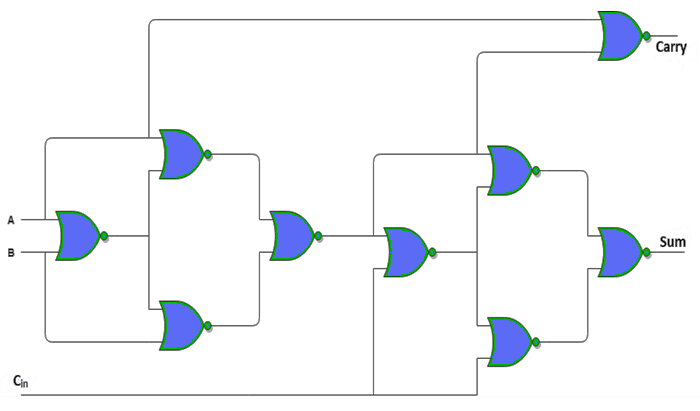
How Many Nand Gates Are Required For Full Adder?
Answer
412.8k+ views
1 likes
Hint: A truth table is a mathematical table used in logic (specifically in connection with Boolean algebra, boolean functions, and propositional calculus) that lists the functional values of logical expressions for each of their functional arguments, that is, for each set of values taken by their logical variables.
Complete step by step solution:
A Full Adder is a Combinational Logic Circuit that adds two-digit integers in binary. When compared to half adders, full adders are more complicated and difficult to install. The major difference between a full adder and a half adder is that a full adder calculates the sum of three binary bits. Two of the three bits, A, the augend bit, and B, the addend bit, are the same as previously. The third bit is called Carry–in and is typically denoted as
Truth table of full adder is given as
A Full Adder requires a total of 9 NOR gates to be implemented.

Note: An adder is a digital circuit that adds two integers together. Adders are used in the arithmetic logic units (ALU) of many computers and other types of processors. They're also used to compute addresses, table indices, increment and decrement operators, and other operations in other sections of the CPU.
Complete step by step solution:
A Full Adder is a Combinational Logic Circuit that adds two-digit integers in binary. When compared to half adders, full adders are more complicated and difficult to install. The major difference between a full adder and a half adder is that a full adder calculates the sum of three binary bits. Two of the three bits, A, the augend bit, and B, the addend bit, are the same as previously. The third bit is called Carry–in and is typically denoted as
Truth table of full adder is given as
| input | output | |||
| A | B | Cin | Cout | S |
| 0 | 0 | 0 | 0 | 0 |
| 0 | 0 | 1 | 0 | 1 |
| 0 | 1 | 0 | 0 | 1 |
| 0 | 1 | 1 | 1 | 0 |
| 1 | 0 | 0 | 0 | 1 |
| 1 | 0 | 1 | 1 | 0 |
| 1 | 1 | 0 | 1 | 0 |
| 1 | 1 | 1 | 1 | 1 |
A Full Adder requires a total of 9 NOR gates to be implemented.

Note: An adder is a digital circuit that adds two integers together. Adders are used in the arithmetic logic units (ALU) of many computers and other types of processors. They're also used to compute addresses, table indices, increment and decrement operators, and other operations in other sections of the CPU.
Latest Vedantu courses for you
Grade 11 Science PCM | CBSE | SCHOOL | English
CBSE (2025-26)
School Full course for CBSE students
₹41,848 per year
Recently Updated Pages
Master Class 4 Maths: Engaging Questions & Answers for Success

Master Class 4 English: Engaging Questions & Answers for Success

Master Class 4 Science: Engaging Questions & Answers for Success

Class 4 Question and Answer - Your Ultimate Solutions Guide

Master Class 11 Economics: Engaging Questions & Answers for Success

Master Class 11 Business Studies: Engaging Questions & Answers for Success

Trending doubts
Give 10 examples of unisexual and bisexual flowers

Draw a labelled sketch of the human eye class 12 physics CBSE

a Tabulate the differences in the characteristics of class 12 chemistry CBSE

Differentiate between homogeneous and heterogeneous class 12 chemistry CBSE

Why is the cell called the structural and functional class 12 biology CBSE

Differentiate between insitu conservation and exsitu class 12 biology CBSE




